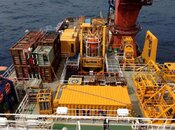Tigerman
Contributor
It would surprise me if there ISNTHa!... That wouldn't surprise me!
Welcome to ScubaBoard, the world's largest scuba diving community. Registration is not required to read the forums, but we encourage you to join. Joining has its benefits and enables you to participate in the discussions.
Benefits of registering include
It would surprise me if there ISNTHa!... That wouldn't surprise me!
... I'm sure there is much more to the story than the news media got right.

NOAA buoy Station 13010 is the nearest, currently showing 82.4 F water - and I doubt that it changes much nor has a thermocline. I'm sure the trapped cook was "freezing."One newscaster stated that the water temperature was below freezing. Granted, sea water freezes at 28° F/−2 °C, but 5° above the equator in 100'/30 Meters of water I dont think so. I guess journalism school doesnt require physiology or geography.
NOAA buoy Station 13010 is the nearest, currently showing 82.4 F water - and I doubt that it changes much nor has a thermocline. I'm sure the trapped cook was "freezing."
Im not sure that is a fair assumption. A big clue was the sat diver just brought a Kirby-Morgan band mask and harness. If the sea water was even moderately cool they would have put him in a hot water suit first. Also the video didnt show the sort of erratic muscle movement of someone who felt cold.
Moderate hypothermia is a core temperature of 2832 °C (8290 °F). It looked like he could keep the majority of his body out of the water and the air temperature was probably in the high 70s to low 80° F. range.
I suspect he didnt feel freezing until the swim back to the bell because (I assume) they were in HeO2. Low 80s F, especially unprotected in the water, is excruciatingly cold on Heliox. The bell and chamber at that depth are probably kept around 88-89° F to be comfortable with a comfort zone in the +/-½° range.
| Times as conductive as air | W/(m·K) | Name |
| 1.0 | 0.024 | Air (gas) |
| 0.7 | 0.016 | Argon (gas) |
| 0.6 | 0.0146 | Carbon dioxide (gas) |
| 5.9 | 0.142 | Helium (gas) |
| 7.0 | 0.168 | Hydrogen (gas) |
| 90.8 | 2.18 | Ice (0°C, 32°F) |
| 1.0 | 0.024 | Nitrogen |
| 1.0 | 0.024 | Oxygen |
| 24.2 | 0.58 | Water |

